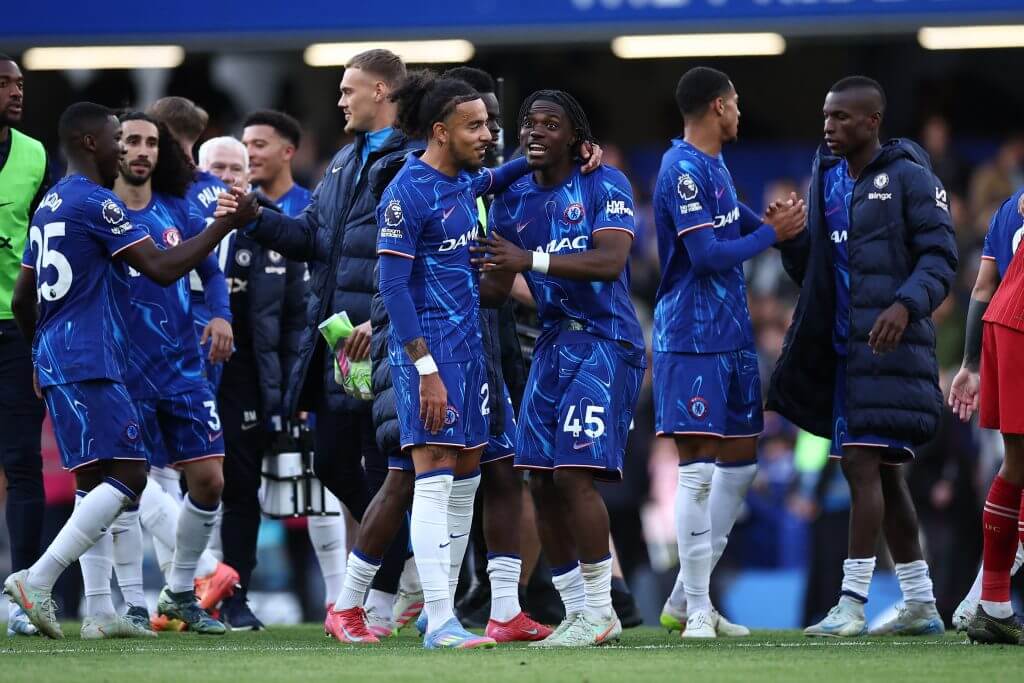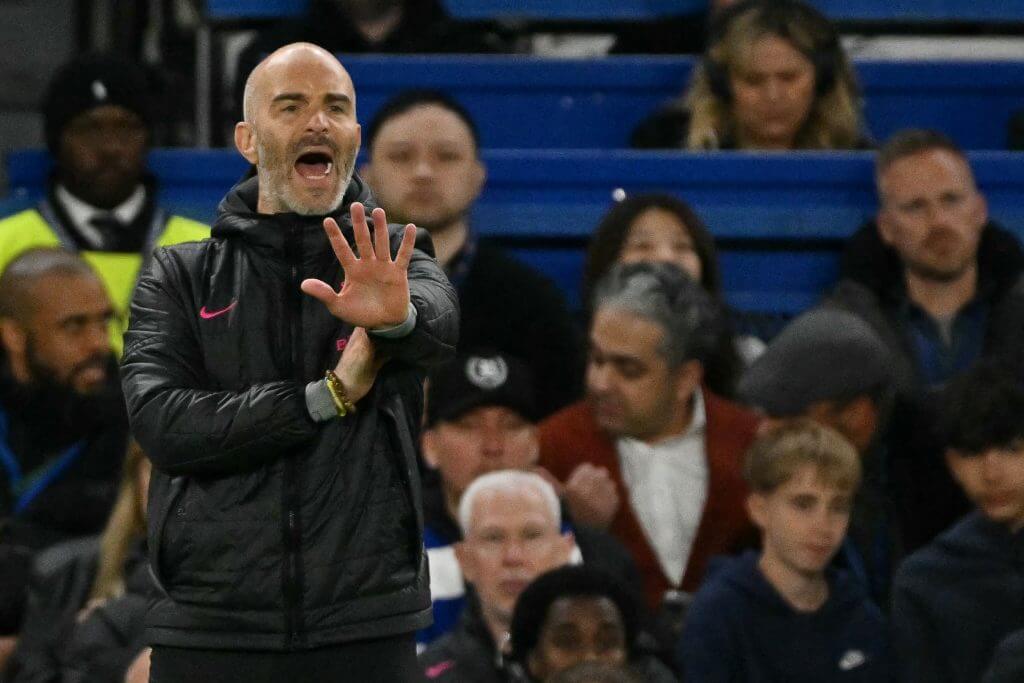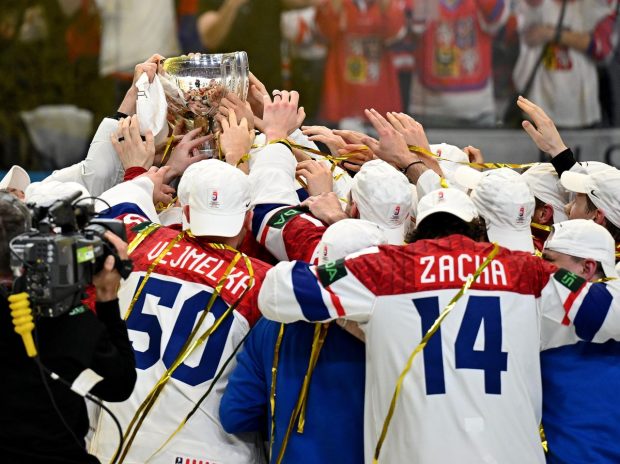
Chelsea recorded their lowest share of possession in any Premier League match this season against Liverpool last weekend and produced one of their best performances of it.
Despite having the ball just 35.3 per cent of the time against the newly-crowned Premier League champions at Stamford Bridge, Chelsea scored three times in a 3-1 victory. They also generated their fourth-best expected goals value (3.1 xG) of the league season — a number boosted by Moises Caicedo winning a golden chance for Cole Palmer to end his 18-game scoring drought from the penalty spot in the 96th minute.
Advertisement
Enzo Maresca’s team were far more aggressive when they did get the ball, generating five fast breaks (defined by Opta as a fast counter-attack starting from a team’s own half with the opposition defence at least partly unsorted) and six direct attacks (classified as the number of open-play sequences that begin just inside a team’s own half and have at least 50 per cent movement towards the opposition goal, ending in a shot or touch in the penalty area).
Both equalled Chelsea’s season highs in the Premier League in those respective categories.
The performance evoked memories of the faster, more dynamic young team that rose as high as second in the table before the turn of the year, even while performing in a manner that Maresca regularly warned was putting his players at risk of becoming embroiled in “basketball games”.
Speed and style of play have been points of contention at Stamford Bridge all season. Chelsea’s frequency of direct attacks has plummeted since the turn of the year, and many supporters subscribe to the theory that the more this young team has committed to the more possession-focused principles of so-called Marescaball, the worse they have become.
The manner of that victory against Liverpool raised an adjacent question: are this Chelsea team better when they have less of the ball?

Chelsea beat Liverpool with only 35.3 per cent possession (Henry Nicholls/AFP via Getty Images)
The answer, as you might imagine, is not entirely straightforward.
Chelsea have enjoyed the majority of possession in 27 of their 35 Premier League matches so far this season — no great surprise for a team who aspire to control and create with the ball. Maresca’s team have a winning record in those matches (W15 D8 L4) and a losing record in the eight where they have had less than 50 per cent of the ball (W3 D1 L4).
That in itself does not tell us all that much.
More interesting is the picture that emerges when we divide those 35 matches into degrees of possession.
Advertisement
(A couple of important notes: firstly, possession as a statistic provides a broad indicator of the general flow of a match, rather than a detailed picture of the shifting state of the scoreline over 90 minutes. Secondly, dividing a single season into subsets inevitably means dealing with sample sizes too small to yield concrete conclusions, but they can still sometimes give us an idea of what is going on.)
That being said, in the 12 league matches where Chelsea have enjoyed between 50 and 59.9 per cent possession, they have performed pretty well (full record: W7 D3 L2). They average 1.7 goals scored per game in those dozen outings, exactly in line with their average xG in that span (1.7), and have only conceded 0.8 goals per game, a slightly fortunate return on 1.1 average xG against.
That record improves slightly in the 12 league fixtures where they have had 60 to 69.9 per cent possession (W8 D3 L1), despite Chelsea’s average xG against in those games rising to 1.4. Opponents have marginally underperformed that (1.3 average goals conceded), but the bigger difference is that Maresca’s team create more: an average xG of 2.0, which they have overperformed by averaging 2.2 goals per match.
One factor in that attacking improvement may be that, counterintuitively, Chelsea have actually managed to average significantly more fast breaks (1.9, up from 1.3) and direct attacks (2.9, up from 2.6) in the matches where their possession percentage has ticked up into the 60s. It is important to note here that while Maresca wants his team to keep the ball, he also wants them to move forward quickly once they manage to beat the first line of opposition pressure and create a numerical advantage.
Opponents also carry more of a threat in these matches, averaging 11.8 shots on Chelsea’s goal (up from 7.9), while there is a marginal uptick in the direct attacks that Maresca’s team faces (0.6 per game, up from 0.5).
The seven Premier League games in which Chelsea have been restricted to between 40 and 49.9 per cent possession include both meetings with Manchester City, Arsenal’s visit in November and the west London derby at home to Fulham the following month. None of those matches yielded three points for Chelsea, but this small sample is boosted by two of the bigger victories Maresca’s team have earned this season: the 4-2 home win over Brighton and Hove Albion and the 3-0 away rout of West Ham, both in September.
Advertisement
When they have less of the ball, the indications are that Chelsea concede marginally more shot attempts (an average of 13.6 per game) than they generate (13). Both boxes have also been cruel to them in these matches: they average 1.6 goals scored against an average xG of 2.0 while conceding 1.7 goals per game from chances worth an average xG against of 1.6.
But that xG-against figure is too high for Chelsea’s liking in any case. Opponents also average one fast break in these matches which, coupled with the sheer number of shot attempts that goalkeeper Robert Sanchez faces, are potential indicators that they are not yet as difficult to play through as they need to be.
So far, so good in terms of Maresca’s insistence that his players need to dominate the ball to succeed — but there are also reasons to believe that possession has its limits.
Chelsea have won none of the three Premier League games where they’ve had 70 per cent possession or more: both meetings with Ipswich Town and the goalless draw at Everton in December.
Maresca might reasonably argue that his team were unlucky in these three matches, all of which they won on xG. But here we run up against the limitations of the numbers; xG, like possession, is a full-time statistic which does not reflect game state. Ipswich carved through Chelsea to surge into two 2-0 leads, then basically defended for the rest of those games. Everton set up to frustrate in a low block from the off.

Maresca has spoken about the risks of playing on the break (Glyn Kirk/AFP via Getty Images)
Facing massed, deep-lying defences, Chelsea’s opportunities to advance the ball quickly disappear almost completely: they generated just one fast break and four direct attacks across those three games, while giving up eight of each. As anyone who watched those laboured performances will attest, the control Maresca’s team exerted was brittle and frequently broken by more dogged, decisive opponents.
Chelsea only scored two goals from a cumulative total of 66 shot attempts away to Everton and in the two meetings with Ipswich. That sounds unsustainably bad, but it is also worth noting that their average xG per shot attempt was only 0.08 — significantly lower than other Premier League matches in which they had less possession. Put simply, they generated a higher quantity of lower-quality shots.
How possession impacted Chelsea display
| Opponent | Date | Possession | Goals | Goals Conceded | xG for | xG against |
|---|---|---|---|---|---|---|
|
Ipswich Town |
30/12/24 |
75.86 |
0 |
2 |
2 |
1.58 |
|
Everton |
22/12/24 |
74.97 |
0 |
0 |
1.17 |
1.03 |
|
Ipswich Town |
13/4/25 |
73.5 |
2 |
2 |
2.27 |
1.07 |
|
Brighton and Hove Albion |
14/2/25 |
69.49 |
0 |
3 |
0.54 |
1.42 |
|
West Ham United |
3/2/25 |
67.9 |
2 |
1 |
1.67 |
1.22 |
|
Bournemouth |
14/9/24 |
66.7 |
1 |
0 |
0.77 |
1.77 |
|
Nottingham Forest |
6/10/24 |
66.11 |
1 |
1 |
2.46 |
0.87 |
|
Aston Villa |
1/12/24 |
64.08 |
3 |
0 |
1.69 |
1.23 |
|
Leicester City |
23/11/24 |
63.27 |
2 |
1 |
2.75 |
1.1 |
|
Wolverhampton Wanderers |
20/1/25 |
62.83 |
3 |
1 |
3.2 |
0.81 |
|
Crystal Palace |
1/9/24 |
62.78 |
1 |
1 |
2.37 |
0.54 |
|
Brentford |
15/12/24 |
61.73 |
2 |
1 |
2.23 |
1.61 |
|
Crystal Palace |
4/1/25 |
61.59 |
1 |
1 |
1.24 |
1.08 |
|
Tottenham Hotspur |
8/12/24 |
61.47 |
4 |
3 |
2.83 |
2.9 |
|
Wolverhampton Wanderers |
25/8/24 |
60.4 |
6 |
2 |
1.69 |
1.96 |
|
Southampton |
25/2/25 |
59.58 |
4 |
0 |
2.56 |
0.72 |
|
Fulham |
20/4/25 |
59.28 |
2 |
1 |
0.9 |
0.25 |
|
Arsenal |
16/3/25 |
59.11 |
0 |
1 |
0.36 |
0.71 |
|
Brentford |
6/4/25 |
59.08 |
0 |
0 |
1.23 |
1.18 |
|
Liverpool |
20/10/24 |
57.54 |
1 |
2 |
0.99 |
1.94 |
|
Bournemouth |
14/1/25 |
56.89 |
2 |
2 |
2.5 |
1.18 |
|
Leicester City |
9/3/25 |
56.62 |
1 |
0 |
1.78 |
0.1 |
|
Southampton |
4/12/24 |
54.94 |
5 |
1 |
5.43 |
1.56 |
|
Everton |
26/4/25 |
54.73 |
1 |
0 |
0.88 |
0.44 |
|
Manchester United |
3/11/24 |
54 |
1 |
1 |
1.11 |
1.98 |
|
Newcastle United |
27/10/24 |
50.42 |
2 |
1 |
1.61 |
1.81 |
|
Tottenham Hotspur |
3/4/25 |
50 |
1 |
0 |
1.1 |
0.87 |
|
Arsenal |
10/11/24 |
49.32 |
1 |
1 |
1.54 |
1.55 |
|
Manchester City |
18/8/24 |
48.17 |
0 |
2 |
1.01 |
0.77 |
|
Aston Villa |
22/2/25 |
47.82 |
1 |
2 |
2.3 |
2.33 |
|
Fulham |
26/12/24 |
47.06 |
1 |
2 |
1.12 |
1.78 |
|
West Ham United |
21/9/24 |
46.95 |
3 |
0 |
2.19 |
0.85 |
|
Manchester City |
25/1/25 |
43 |
1 |
3 |
1.8 |
2.5 |
|
Brighton and Hove Albion |
28/9/24 |
41.05 |
4 |
2 |
4.16 |
1.11 |
|
Liverpool |
4/5/25 |
35.25 |
3 |
1 |
3.13 |
1.05 |
What these players do with the ball, and how quickly they do it, will continue to consume those Chelsea fans who remain deeply ambivalent about this style of football. Maresca acknowledged as much last month, while pointing out that the opponent’s strategy will always have an impact on the watchability of the end product.
Advertisement
“The only thing I can say is that I think the last six Premier League games at home, we faced Southampton, Leicester, Wolves, West Ham, Spurs and Ipswich,” he said. “We won five of six, and probably the one that the people more enjoyed was the Spurs one (a 1-0 Chelsea win). But Spurs was the only team in the last six games at home that were trying to press higher.
“So, this is the reason why probably we attack more and we attack more quick. But against the rest, that they just wait inside the box, it’s a different game. So, we need to learn how to play different kinds of games. And then we change. Tactically, we change. Game by game, we change.”
On this season’s (admittedly limited) evidence, Chelsea are more likely to drop points when they don’t have enough of the ball and when they see too much of it.
A big part of Maresca’s job is to find the most productive balance.
Achieve that, and more consistent results — and perhaps even a few thrills — will follow.
(Top photo: Justin Tallis/AFP via Getty Images)
This news was originally published on this post .










Be the first to leave a comment